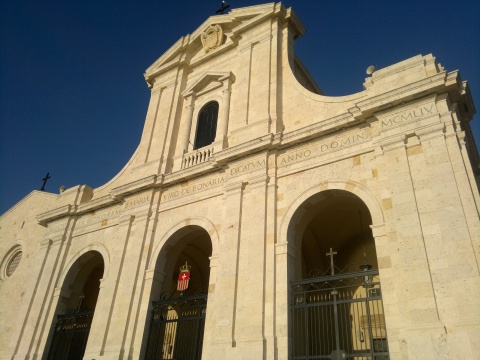The Bonaria district is located on the homonymous hill and in its surroundings, in the south-eastern part of the town of Cagliari.
The neighbourhood is enclosed by Sonnino street, Grazia Deledda, Pessina and Pineta, by the New Median Scrolling Axis and, to the south, it extends to the sea (beach and small port of Su Siccu).
Human settlements in the Bonaria area date back to the Punic, as evidenced by the necropolis found on the hill, which was later reused by the Romans and then transformed into a quarry.
During the Middle Ages the church of San Bardilio was built, in Romanesque-Pisan and Italian Gothic style. The church doesn’t longer exist today, since, following abandonment and structural degradation, it collapsed in 1909 and was definitively demolished 20 years later.
In 1324, on the top of the Bonaria hill, the Aragoneses built a fortified citadel, which was the first capital of the Kingdom of Sardinia for two years and which was used for the siege of Castel di Castro (the current Castello district). At the time, the location was renamed Buen Ayre (good air), then Italianized in Bonaria.
The chapel of the fortified citadel was later transformed into a Marian sanctuary and next to the fourteenth-century church, still in existence, the Basilica of Our Lady of Bonaria was later built, which in addition to being the main Marian sanctuary of Sardinia, is also one of the monuments more impressive and spectacular not only in the neighbourhood but in the whole city of Cagliari. A beautiful park has also been created behind the Basilica and on the slopes of the Bonaria hill, also known as a panoramic point.
Next to it is the nineteenth-century monumental cemetery of Bonaria. Built on a part of the ancient Phoenician-Punic necropolis, it still houses the burials of numerous illustrious Cagliari’s citizens.
The residential part of the Bonaria district has developed around the hill and on part of it, becoming a densely populated but quiet and elegant area. The street that crosses the neighbourhood, Milano street, is composed of fine villas which, from the early 1900s, began to be the residences of the Cagliari upper middle class, and from more popular but well-built buildings, with architectural styles ranging from deco to the neo medieval, from the eclectic to the rationalist.
The houses are surrounded by gardens and large green spaces, crowded with tall trees (note is the beautiful flowering of the jacarandas in spring and autumn), creepers and flowers of all kinds.
The Bonaria district is also one of the economic, tourist and administrative centers of Cagliari: there are important banking and insurance offices, prestigious hotels, numerous bed & breakfasts, sports facilities and the Trade Fair District (Sardinia International Fair).
Finally, in “One hundred thousand’s” square, at the foot of the Bonaria staircase, the Campagna Amica market is held every Thursday, with the direct sale by the producer to the consumer of the agricultural and food and wine products from the countryside of the province of Cagliari.
Quartiere Bonaria
Quartiere Bonaria
Quartiere Bonaria
City
CagliariAdd new review
Your review will be visible after approval by the editors
To post a review you must be an authenticated user.
Log in with Social Login
